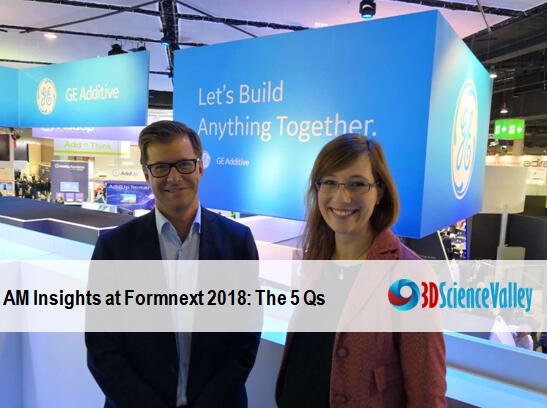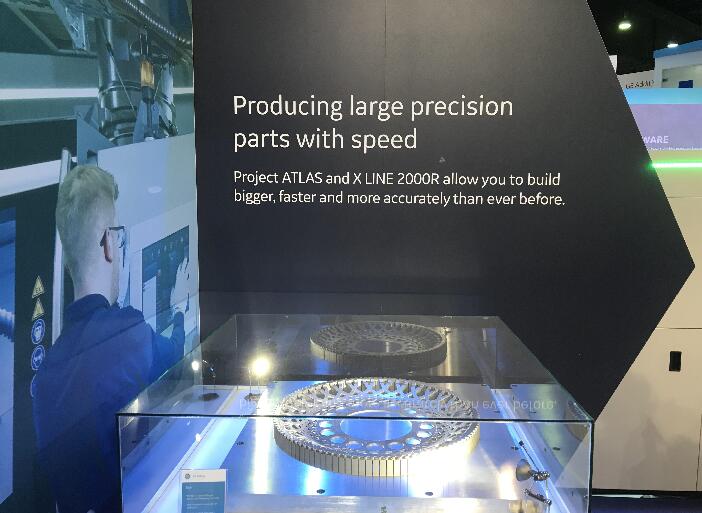AM Insights at formnext: 3D Science Valley interviewed with Karl Lindblom, CEO of GE ArcamEBM

Left: Karl Lindblom, CEO of GE ArcamEBM
Right: Korinna Penndorf, Co-founder of 3D Science Valley
Q1: What’s your highlights here at Formnext?
For me it is fascinating to see how this exhibition is growing year by year. This year we have, I think, almost twice as many exhibitors as last year and it is fascinating how much attention this industry is getting now. I met some former colleague from the conventional industries and they also want to be here as suppliers next year. So I believe this show will continue to grow. That’s a good sign for the industry as such.
Since I am from Arcam EBM I will focus on the EBM technology we show here which is our latest development called Arcam Spectra H. It is a new platform intended to be used for hot material, which is where we are unique of course. From a technology point of view also with this machine we are improving productivity, reliability – really taking a big step with our technology into the next five years.

Image: GE booth at formnext
Korinna Penndorf: Looking around, there is a lot of noise and it feels nearly every other company says they are the absolute game changer and breakthrough in additive manufacturing. Where do you stand as ArcamEBM and how do you perceive this?
We are standing out, I think, because we offer end-to-end solutions. That means we have AddWorks, you could call that engineering services, we have machines, we have powder, we have software but we also have services. So I think we are one of the few players that can help the customers from A to Z on their additive journey and that’s why we stand out in my opinion. We have a number of cases where we helped the customer from the initial design review until the machine was up and running.

Q2: If you look at how the business has been faring this year as opposed the previous one, what has been the development?
The official statistic is saying that the additive industry is growing with 23, 24 percent and that is in the neighbourhood where we are also. For us this year has been a good year.

Korinna Penndorf: So what has been reported in analysis by Context and such, you would confirm that?
Yes, we would confirm that.
Q3: What is the current challenge for you at the moment . the problem you are trying to solve in the near future?
I think in general the challenge is to go from the research to industrialisation. A lot of companies have a number of years into this technology and now they have to take the next step, which is basically going into serial production. We need to hold hand with a lot of customers on this journey. That’s also why I think we will be successful. We have the size, the manpower, the knowledge to help the customer on this journey. So I think that is the biggest challenge.

First Concept Laser M LINE FACTORY systems to be delivered in Q2 2019. (Photos: GE Additive, GEADPR010)
Korinna Penndorf: That is also an investment, I believe, from your side?
It’s a huge investment, but it is now really the time to show that on that research money, you can get the payback on it. This is why we have to make sure we take the technology out of the research departments into the manufacturing area.

Q4: How would you look at the year 2018 for the overall industry: what’s been the major developments and obstacles for the industry?
I would say, additive has been extremely strong in highly regulated industries such as the aerospace and medical, but I think we see a broader market now opening up. We see a lot of interest from the automotive industry and others also. The acceptance for the technology is becoming bigger and bigger actually. I expect to see that continue the coming years.
At the end of the day you need to have a good business case. Without a good business case everything falls apart basically. That is why it is so important now to take AM from the research area to the industrialisation phase. That’s where we need to help our customers not only taking a part they already have, but helping them to redesign the part and to optimize it for AM. Help them to set up the production in the most efficient way. Train them how to run and operate the machine in a professional way. Help them through the validation process and maybe help them to shorten that time also. Help them to keep the machine running and producing parts. That’s the biggest challenge still for the coming years.

Q5: How do you think things will develop over the next 5 years?
There are a lot of companies right now. I think you will see a consolidation, but what I expect to see more from a technology point of view or from an industrialisation point of view is that we are talking more about that complete system. We are still very machine oriented. We are talking a lot about the machine performance, but the machine is only one piece in the whole value chain. We as a company will focus much much more on the whole system and I think you will see that in general. I think our offering will change over the next 5 years to much more products and solutions in the future from us pre-machine solutions and post-processing equipment.
If you look at our industry compared to conventional manufacturing, it is still very manual and research oriented and that needs to be changed over the next 5 years in order to increase the competitiveness of our technology.
Korinna Penndorf: Will this have been achieved in 5 years or will be still be on the way?
I think it will be done. We are moving fast.I see that happening.




Recent Comments